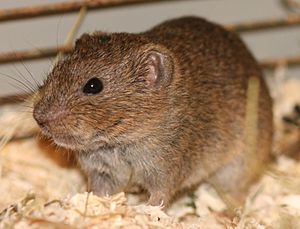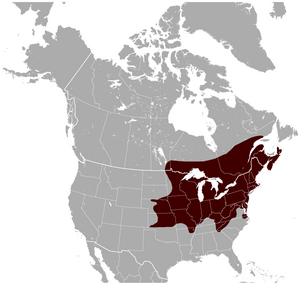Southern bog lemming facts for kids
Quick facts for kids Southern bog lemming |
|
|---|---|
 |
|
| Conservation status | |
| Scientific classification | |
| Genus: |
Synaptomys
|
| Species: |
cooperi
|
 |
|
| Southern Bog Lemming range | |
The southern bog lemming (Synaptomys cooperi) is a small rodent found in North America. It's a type of lemming. These lemmings live in many parts of eastern North America. They share some areas with their relatives, the northern bog lemming, especially in southeastern Canada. However, southern bog lemmings live much further south too.
Contents
About the Southern Bog Lemming
Southern bog lemmings have thick, brownish fur on their backs. This fur can be reddish or dark brown. Their bellies are a silver-gray color. They have a rather large head and small eyes. Their ears are tiny and mostly hidden by their puffy head fur.
A special feature of this lemming is its upper front teeth. These teeth have shallow grooves. They also have a short tail, which helps tell them apart from other rodents. Southern bog lemmings are about 13 cm (5.1 in) long. Their tail is about 2 cm (0.79 in) long. They usually weigh around 35 g (1.2 oz).
On their front feet, they have four toes and a small thumb with a nail. Their back feet have five toes. Female southern bog lemmings have six teats. This is different from northern bog lemmings, which have eight.
Where They Live
Southern bog lemmings live in eastern North America. You can find them from southern Quebec and Manitoba in Canada. Their range goes south to western Minnesota and southwestern Kansas. It also stretches east to the Atlantic Coast of the United States.
These lemmings prefer forests with both deciduous (trees that lose leaves) and coniferous (evergreen) trees. They especially like the grassy edges and open spots in these forests. Places with sedges, ferns, and shrubs are favorites. They also like loose, crumbly soil. They can live in wetter or drier areas if there aren't many meadow voles around.
Southern bog lemmings are good builders. They create many tunnels and paths that connect underground. They also build nests from plant fibers. In summer, their nests are on the ground or hidden in clumps of grass. In winter, they usually build their nests underground inside a larger tunnel.
What They Eat
Southern bog lemmings mainly eat fresh plants. They enjoy the leaves, stems, seeds, and roots of grasses and sedges. They also eat fruits like raspberries and blueberries. Sometimes, they munch on insects, fungi, and tree bark.
They store grasses and sedge stems in underground rooms. This helps them have food ready. These animals are active all year long. They do not hibernate, which means they don't sleep through the winter. They often live in small groups.
Lemming populations can change a lot. Their numbers go up and down in a cycle that lasts about 3 or 4 years. They are mostly active at night. They make paths through the plants on the surface and also dig burrows underground.
Reproduction and Life Cycle
Southern bog lemmings can have babies at any time of the year if there is enough food. A female lemming is pregnant for about 21 to 23 days. When the babies are born, they are blind and have no fur. They do have claws right away.
By the end of their first week, the young lemmings grow fur. They open their eyes when they are about 12 days old. They stop drinking their mother's milk at about 3 weeks of age. Male southern bog lemmings can start having their own babies when they are about 5 weeks old. Most lemmings breed before they are fully grown. Most southern bog lemmings live for less than a year.
How They Communicate
Southern bog lemmings use different ways to talk to each other. They are thought to use scent marking. This means they leave their smell in places to send messages. They also make squeaking sounds. Other ways they communicate include using sounds, chemicals, sight, and touch.
Predators
Many animals hunt southern bog lemmings. Their predators include owls and hawks. Other hunters are red foxes, gray foxes, and even domestic dogs. Badgers, weasels, snakes, bobcats, and house cats also prey on them.
Sadly, two types of southern bog lemmings have become extinct. These are the Kansas bog lemming (S. c. paludis) and the Nebraska bog lemming (S. c. relictus).


